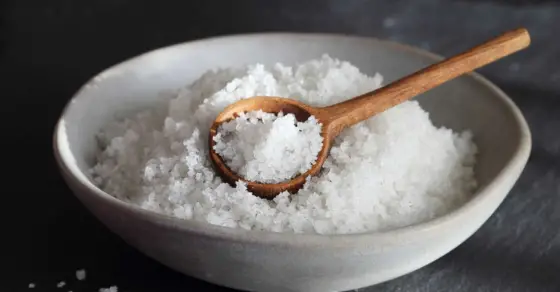Heavy Metals in Salt Brands: What You Need to Know
Recent testing has revealed that many popular salt brands contain trace amounts of heavy metals, including aluminum, arsenic, cadmium, and lead. While the levels found are within safety limits, understanding the presence of these metals in your salt can help you make informed choices.
Testing Salt for Heavy Metals
Mamavation sent 23 salt products to an EPA-certified lab to be tested for aluminum, arsenic, cadmium, mercury, lead, and microplastics. The results showed that all salt products contained detectable amounts of heavy metals, though none reached levels that would require a Prop. 65 warning in California. Additionally, microplastics were detected but not in quantities high enough for conclusive identification.
Before we get into the levels of heavy metals in the salts however, let’s first explore the dangerous health effects of metals like aluminum, arsenic, cadmium, mercury and lead.
The Hidden Dangers: Aluminum, Arsenic, Cadmium, Mercury, Lead, and Microplastics
In today’s world, we’re increasingly aware of the substances that can impact our health, from the food we eat to the air we breathe. Among the most concerning are heavy metals and microplastics, which can have severe health implications if we’re exposed to them over time. This article explores the dangers of aluminum, arsenic, cadmium, mercury, lead, and microplastics, highlighting their potential health risks and why it’s crucial to limit our exposure.
1. Aluminum: The Silent Neurotoxin
Health Risks:
Aluminum is commonly found in products like cookware, food packaging, and even in some medicines and cosmetics. While it’s less toxic than other heavy metals, chronic exposure to aluminum has been linked to neurodegenerative diseases such as Alzheimer’s. Aluminum can cross the blood-brain barrier, potentially leading to the formation of amyloid plaques—a hallmark of Alzheimer’s disease. It can also interfere with the body’s ability to absorb calcium, which is vital for bone health.
Sources:
- Cookware (especially when scratched or damaged)
(Click here to get non-toxic Ceramic cookware) - Processed foods and additives
- Antiperspirants (Click here to read about the most dangerous deodorant chemicals)
- Vaxcxines (Intentionally misspelled – as an adjuvant)
2. Arsenic: The Dangerous Carcinogen
Health Risks:
Arsenic is a well-known carcinogen, meaning it can cause cancer in humans. Long-term exposure, even in small amounts, can lead to skin lesions, developmental effects, cardiovascular disease, neurotoxicity, and diabetes. The most concerning effect of arsenic exposure is an increased risk of cancers, particularly skin, lung, and bladder cancer. Chronic exposure to arsenic-contaminated water is a major health concern in many parts of the world.
Sources:
- Contaminated drinking water (Click here to read about the 5 different types of water to drink and how to remove heavy metals from drinking water)
- Rice and rice-based products
- Certain pesticides and herbicides
- Industrial processes
3. Cadmium: The Kidney Killer
Health Risks:
Cadmium is highly toxic and primarily affects the kidneys, causing renal dysfunction. Prolonged exposure can also lead to bone demineralization, contributing to diseases like osteoporosis. Cadmium exposure is associated with an increased risk of lung cancer and is particularly dangerous because it accumulates in the body over time, with a biological half-life of about 10-30 years.
Sources:
- Tobacco smoke
- Contaminated food (especially rice, cereals, and leafy vegetables)
- Batteries and industrial emissions
- Phosphate fertilizers
4. Mercury: The Toxic Element
Health Risks:
Mercury is highly toxic, especially in its organic form, methylmercury, which is found in contaminated fish and seafood. Mercury exposure can severely affect the nervous system, leading to cognitive impairments, motor dysfunction, and emotional disturbances. Pregnant women are particularly vulnerable, as mercury can cross the placental barrier and harm the developing fetus, leading to developmental delays and cognitive deficits.
Sources:
- Contaminated fish and seafood (e.g., tuna, swordfish)
- Dental amalgams
- Industrial emissions
- Certain vaxccines (Intentionally misspelled – as a preservative)
5. Lead: The Age-Old Poison
Health Risks:
Lead exposure is a significant health risk, particularly for children. It can cause irreversible damage to the brain and nervous system, leading to cognitive impairments, behavioral issues, and learning disabilities. Even low levels of lead exposure can affect a child’s development. In adults, lead exposure can cause hypertension, kidney damage, and reproductive issues.
Sources:
- Lead-based paints
- Contaminated water (from lead pipes) (Click here to learn how to remove heavy metals from drinking water)
- Certain toys and cosmetics
- Occupational exposure (e.g., construction, battery manufacturing)
6. Microplastics: The Ubiquitous Pollutant
Health Risks:
Microplastics are tiny plastic particles that have infiltrated nearly every corner of the environment, from the deepest oceans to the highest mountains. While research is still ongoing, there is growing concern that microplastics may cause harm to human health. They can carry toxic chemicals, including endocrine disruptors, which can interfere with hormone systems, potentially leading to reproductive issues, obesity, and developmental problems. Ingested microplastics can also cause inflammation and stress in the digestive system.
Sources:
- Breakdown of larger plastic debris
- Synthetic fibers from clothing
- Personal care products (e.g., exfoliants, toothpaste)
- Food and water contamination
Minimizing Exposure and Protecting Your Health
Reducing exposure to these harmful substances is crucial for long-term health. Here are some steps you can take:
- Use safer cookware: Opt for stainless steel, cast iron, or glass cookware to avoid aluminum exposure.
- Filter your water: Ensure your drinking water is free from heavy metals like arsenic and lead by using a high-quality water filter. Click here to learn about the best way to filter water from toxic heavy metals, chlorine, fluoride and more.
- Be mindful of seafood: Limit consumption of high-mercury fish and choose options with lower mercury levels, such as salmon and sardines.
- Check labels: Avoid products with known contaminants, such as lead-based cosmetics and microplastics in personal care items.
- Support clean environments: Advocate for stricter regulations on industrial emissions and the use of hazardous materials.
Understanding the risks associated with heavy metals and microplastics is the first step toward protecting your health. By taking proactive measures, you can reduce your exposure and minimize the potential dangers these substances pose.
Click here to visit Baja Gold Sea Salt. Use the discount code: HealthyWildFree to get a discount at checkout.
Click here to visit Colmina Sea Salt.
Key Findings From The Salt Study:
- Aluminum: Detected in 78% of salt products, with 35% containing over 100,000 ppb.
- Arsenic: Found in 100% of salt products, with 74% exceeding 10 ppb.
- Cadmium: Detected in 70% of salt products, with 4% containing more than 4.1 ppb.
- Mercury: Not detected in any salt products.
- Lead: Found in 96% of salt products.
- Microplastics: Present but not conclusively identified due to low levels.
Understanding MDR (Minimum Detection Levels)
MDR, or Maximum Detection Limit, refers to the lowest level of a substance that can be detected by the laboratory equipment. In this study, MDR indicated the presence of heavy metals at trace levels, meaning the amounts were so low that they were barely measurable.
Here is a list of the salt products tested, ranked from those with the highest heavy metal content to those with moderate levels. The worst salts are listed first, including Real Salt and Celtic Sea Salt.
Salt Products & Their Heavy Metal Test Results


Salt Products With The Lowest Heavy Metals
Among the 23 tested products, Colima Sea Salt and Baja Gold Mineral Sea Salt stood out for having the lowest levels of heavy metals. Both salts showed minimal traces of aluminum, arsenic, cadmium, and lead, with some metals barely detectable at all.
Colima Sea Salt: Click here to visit Colmina Sea Salt’s Website.
They claim to be microplastic free, which I do admire and they have the lowest levels of all metals including Cadmium. It is quite a bit pricier than Baja Gold mineral sea salt however.
- Aluminum: Below MDR
- Arsenic: Below MDR
- Cadmium: 2.29 ppb
- Lead: ND (Not detected)
Baja Gold Mineral Sea Salt: Click here to visit Baja Gold Mineral Sea Salt’s Website.
Use the discount code: HealthyWildFree at checkout.
- Aluminum: Below MDR
- Arsenic: Below MDR
- Cadmium: 3.63 ppb
- Lead: ND (Not detected)
These results make Colima and Baja Gold the top choices for consumers seeking salt products with the lowest heavy metal content.
Conclusion
While all salt products tested contain some level of heavy metals, Colima Sea Salt and Baja Gold Mineral Sea Salt offer the lowest levels overall. By understanding the presence of these metals in your salt, you can make more informed choices for your household.
If you’d like more content like this, please consider joining our Healthy Wild Free newsletter. When you sign up you’ll be on our weekly email list to get new health stories like this one. You’ll also get two free health courses to improve your energy, digestive health, sleep health and more. Subscribe at HealthyWildFree.com today!





